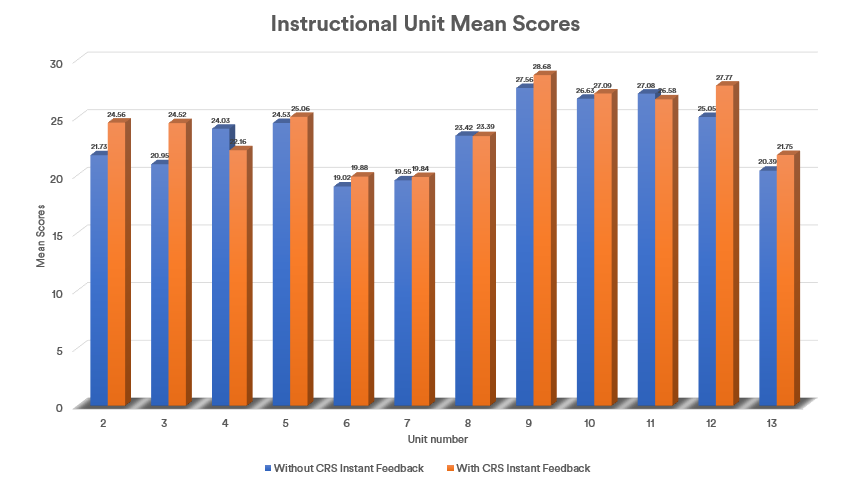Testimonial
Classroom Response Systems are an affordable and versatile classroom assessment tool that can significantly improve student learning. I have been using Qwizdom clickers since 2004 and find it to be an essential and powerful tool that both myself and my students rely on. I use the Answer Key feature daily to help students prepare for ACT exam. Students work independently on practice tests, entering their answers using the Qwizdom Q6 clicker. Each question is instantly graded, letting students, and myself, know what materials need review. Since implementing this daily practice, I have seen students’ test scores improve. I believe a large part of this learning growth is a result of the instant feedback feature. I also use the Qwizdom games as a fast-fire content review, right before testing begins. If the entire group misses a question, we will stop and review the content before moving on.
Not only do Qwizdom Clickers help improve learning, they are proven to be durable and withstand the test of time. The first set of Q4 clickers, that I won in 2004, are still being used today by one of my colleagues. What other technological tool would last for 15 years with minimal maintenance and repairs?
I recently completed a dissertation on the impact of CRS with instant feedback on student learning and it was gratifying to have data to back up my informal observations. See below.
Classroom Response Systems: Does Instantaneous Feedback Affect Students’ Knowledge and Self-Efficacy in a Secondary Science Course
Abstract
Technological advancements have enabled educators to bring excitement in student success with instantaneous feedback utilizing classroom response systems (CRS). A quantitative, quasi-experimental research design was used in this dissertation research to build a comprehensive understanding of the impact of instantaneous feedback with student knowledge and student self-efficacy. The purpose of this study was to illuminate the benefits of instantaneous feedback and student self-efficacy with incorporation of CRS in a secondary science course. Statistical analyses were conducted with quantitative formative scores, summative test scores, and self-efficacy questionnaire results prior to the incorporation of CRS, and perceived self-efficacy questionnaire results after experience with CRS.
Excerpt
CRS is the most affordable, versatile technological tool within the educational setting. Some educators would argue that laptops are the best technology advancement in education, but limitations of cost and accessibility hinder an ideal integration. CRS average approximately $2,000 for a set of 32 clickers, including instructor tablet or remote, and the appropriate software package with computer receiver (Learning Services, 2018). Additionally, individual remotes can be purchased and electronically linked to existing systems to accommodate large classes or replace damaged individual clickers. It would be an unrealistic expectation to outfit thirty-two students with tablets or laptops around the same budget restraints, including the ongoing software updates and constant threat of computer viruses.
Another advantage for the versatility of CRS as the best technological tool within an educational system is its independence. As an independent system, internet access is not necessary for effective integration with students. The receiver can collect information from each clicker to be evaluated by teacher view. Another option is to display the collected responses as a graphic the teacher can share with the class if desired.
Laptop and tablet programs are often innovative and educationally beneficial for students (Zheng & Warschauer, 2016). However, many educators have often experienced difficulty with dependable web connectivity. Many school districts under their own budget restraints have either limited or outdated bandwidth limits for dependable and effective educational use (Herold, 2016).
Results on Hypothesis One
Students who receive instantaneous feedback via classroom response systems during formative/summative assessments will demonstrate a statistically significant increase in knowledge scores with formative/summative assessments.
A SPSS independent t-test was conducted to demonstrate the difference between percentage scores with CRS feedback (M = 79.27, SD = 13.56) and percentage scores without CRS feedback (M = 76.87, SD = 13.99). The assumption of homogeneity of variance was met between these two groups F(1,466) = .190, p = .663. The results of the independent t-test reported a conclusion of a statistically significant difference, t(466) = 2.24, p = .025, d = 0.21. Therefore, student percentage unit scores with CRS feedback were higher than student percentage unit scores without CRS feedback.

Read Complete Study – https://aquila.usm.edu/dissertations/1623/
“Not only do Qwizdom Clickers help improve learning, they are proven to be durable and withstand the test of time. ”
Shani Bourn, PhD, NBCT / HS Science Teacher, 2019
